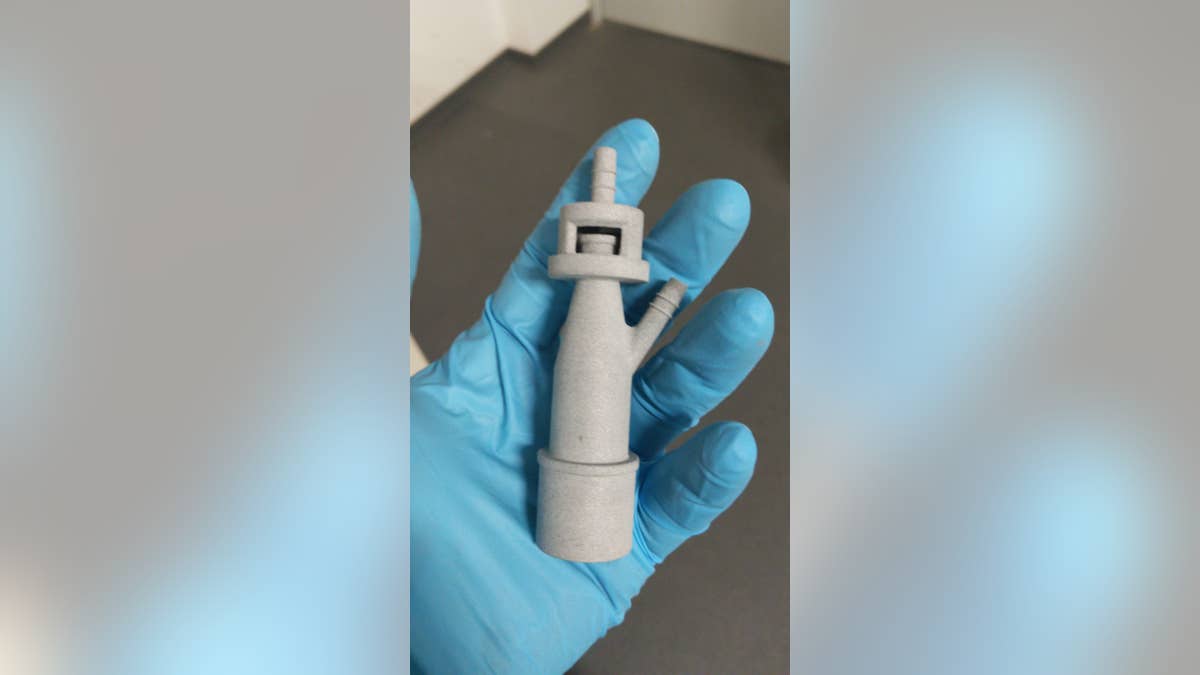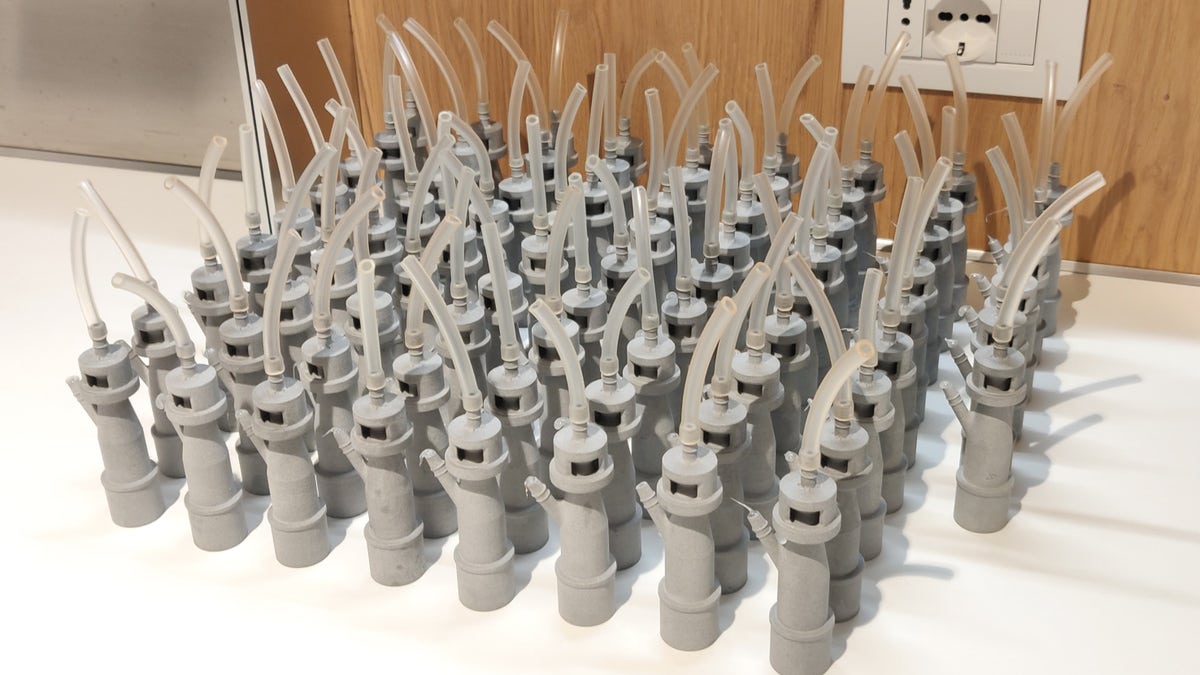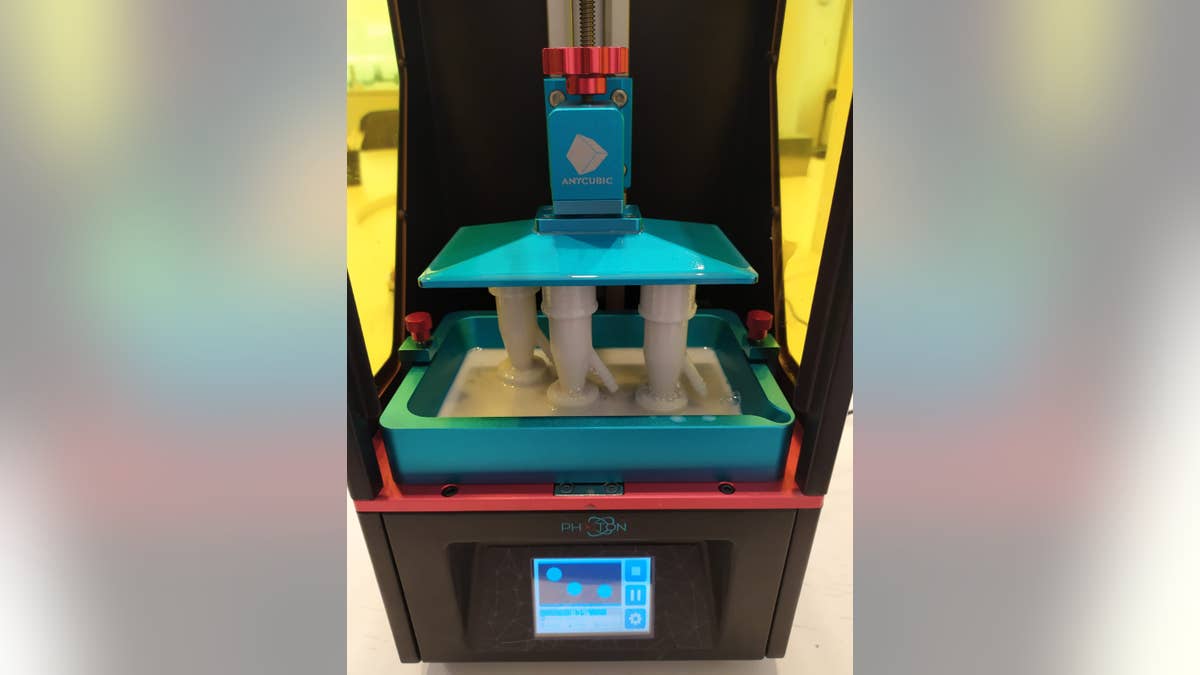Fox News Flash top headlines for March 23
Fox News Flash top headlines are here. Check out what's clicking on Foxnews.com.
Get all the latest news on coronavirus and more delivered daily to your inbox. Sign up here.
As Italy now surpasses China in total deaths as a result of the global COVID-19 pandemic, the European country’s health care system has been hit hard and is struggling to keep up with the flood of critical patients in its hospitals. The death toll in Italy exceeded 5,000 lives lost, as of Monday.
Like many impacted countries, Italy lacks sufficient masks and gloves for their doctors and nurses, and most critically -- ventilators. Because the novel coronavirus is a respiratory illness that can wreak havoc a patient’s lungs, in some cases a patient can require a ventilator to breathe for them and keep them alive.

Alessandro Romaioli (left), and Cristian Fracassi (right) of Isinnova with their 3D-printed ventilator valves.
One such hospital is in Chiari, in the province of Brescia in northern Italy. The surrounding region, Lombardy, is one of the epicenters of the virus.
The hospital, located about an hour east of Milan, has been flooded with patients suffering from the coronavirus. When staff ran out of a crucial valve that connects to the ventilator, the hospital reached out to a local newspaper, to put out the call for help.
Fox News spoke with Isinnova, the Brescia-based business, that stepped up and answered that call. CEO and founder Cristian Fracassi said his staff of 14 were all working from home, as instructed, when he was contacted about the hospital’s needs.

Engineer Romaioli and CEO Fracassi in their Brescia office.
Fracassi said Isinnova is a research center where staff often work on patents, innovative projects and prototypes but had only had one past client in the biomedical field before this week.
Interviewed via video call, Fracassi and his mechanical engineer Alessandro Romaioli said they were connected with the Ospedale di Chiari as soon as they heard about the need for the special lifesaving valves. The hospital was in crisis, they explained, and the manufacturer of the much-needed Venturi valves was unable to get a fresh supply to the hospital. Because the coronavirus pandemic constituted an emergency, Fracassi said that the hospital was permitted to look for outside help to solve the problem.
“The right piece is certified, so the hospital can be sure it doesn’t create any danger,” Romaoili explained, of the reason the hospital generally uses the same manufacturer during normal circumstances. But, because of massive supply chain delays, they had to be creative. “Because lives were in danger, the hospital can use [our 3D-printed version].”

A 3D-printed valve.
Isinnova said it contacted the manufacturer directly to ask for the plans in order to create a replica, but the request was denied.
Fracassi and Romaioli, along with two other employees, went into their office located a little over 15 miles from the hospital, and started brainstorming. They quickly came up with a solution: 3D printing.
The hospital was able to give them a single used and sanitized valve to measure and analyze. The venturi valves are not single-use, they explained, but can only be used on one patient -- not re-used on any other patients.
The Isinnova team took measurements by hand, and after they created a working prototype of the valve, they rushed five samples over to the hospital to be tested on patients.

Fracassi and Romaioli delivering 3D-printed valves to the hospital in Chiari. (Isinnova)
Romaioli and Fracassi waited at the hospital while the doctors tested the valves.
The valves worked.
“We were unable to speak, because of emotion. Maybe we saved some lives? The doctor saved lives, we just helped the doctor,” Romaoili added.
Fracassi and his colleagues completed 95 pieces in 24 hours. “We maybe slept a few hours. I don’t remember,” Romaoili laughed.

3D-printed ventilator valves.
They worked with three different types of 3D printers to get it right and were only slowed down by a small detail: a tiny hole down the center of the valve. “The 3D printer isn’t able to make such a small hole, so we did it by hand,” said Romaoili. “After the production, one by one, and then we washed them” before bringing the 95 ventilator valves to the hospital.
CORONAVIRUS: WHAT YOU NEED TO KNOW
For Fracassi, it was personal. “I didn’t speak to my mother for two days because we were working in a dangerous area, directly in the hospital.” Brescia had been particularly hard hit by the virus. A formerly bustling intersection showed just a few cars out the window of Isinnova’s office.
When asked about the reports that the manufacturer of the original venturi valve had threatened to sue Fracassi or Isinnova, he laughed and called it “fake news”. Other than the initial call to ask for the 3D plans of the valve, Fracassi said he and his company have not had any further conversations with the multinational manufacturer, who he declined to name.

Venturi valves being made in Isinnova's 3D printer.
Since helping the local hospital in Chiari, Isinnova continues to print valves, just in case. They’ve been contacted by various other hospitals and 3D-printing firms in several countries, but the process must begin at the start each time. Different ventilators require different valves, so 3D prototypes have to be made in each instance, since they may not be using the same venturi valves as Chiari.
Asked why the small company jumped so quickly at the chance to problem-solve amidst the global pandemic, Fracassi said, “We love competition. It was a hard competition, we could try to help them, and we won.”
Isinnova didn’t take any payment for the 3D-printed valves. They claim each piece only cost them a few euros worth of materials.
CLICK HERE TO GET THE FOX NEWS APP
“We were trying to do something to help,” Romaoili said. “We didn’t care about our interests, we were interested in making something good for others. That’s why we didn’t ask for money, we just wanted to help. In the days before, we heard about doctors working 20 hours a day, and we were just staying home on our couches.”
“We heard we could do something good to save lives, we said yes -- we have to do that.”

